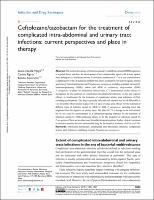Ceftolozane/tazobactam for the treatment of complicated intra-abdominal and urinary tract infections: current perspectives and place in therapy
Resum
Paraules clau
Tractament amb ceftolozane-tazobactam; Infeccions intra-abdominals; Infeccions del tracte superior urinari; Pseudomonas aeruginosa resistentent a medicaments
Citació recomanada
Escolà-Vergé L, Pigrau C, Almirante B. Ceftolozane/tazobactam for the treatment of complicated intra-abdominal and urinary tract infections: current perspectives and place in therapy. Infect Drug Resist. 2019;12:1853–67.
Audiència
Professionals
Empreu aquest identificador per citar i/o enllaçar aquest document
https://hdl.handle.net/11351/4553Aquest element apareix a les col·leccions següents
- HVH - Articles científics [3000]
Els següents fitxers sobre la llicència estan associats a aquest element:

